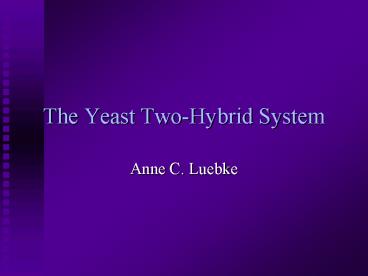The Yeast TwoHybrid System - PowerPoint PPT Presentation
1 / 15
Title:
The Yeast TwoHybrid System
Description:
Identifies mutations that affect protein-protein binding. Can identify interfering proteins in ... Special thanks to Dr. Susan Mango and the University of Utah ... – PowerPoint PPT presentation
Number of Views:142
Avg rating:3.0/5.0
Title: The Yeast TwoHybrid System
1
The Yeast Two-Hybrid System
- Anne C. Luebke
2
What is the yeast two-hybrid system used for?
- Identifies novel protein-protein interactions
- Can identify protein cascades
- Identifies mutations that affect protein-protein
binding - Can identify interfering proteins in known
interactions (Reverse Two-Hybrid System)
3
How does it work?
- Uses yeast as a model for eukaryotic protein
interactions - A library is screened or a protein is
characterized using a bait construct - Interactions are identified by the transcription
of reporter genes - Positives are selected using differential media
4
The Model
Transcription Activating Region
Bait Protein
Prey Protein
DNA-Binding Domain
Reporter Gene
DNA-Binding Site
5
Steps to Screen a Library
- Create the Bait Plasmid Construct from the gene
of interest and the DNA binding domain of Gal4 or
LexA or other suitable domain - Transform with the bait construct a yeast strain
lacking the promoter for the reporter genes and
select for transformed yeast - Transform the yeast again with the library
plasmids - Select for interaction
6
Sequence analysis
- Isolate plasmid from yeast and transform E. coli
- Purify plasmid from E. coli and sequence
- Blast sequence against database for known
proteins or construct a possible protein sequence
from the DNA sequence and compare to other
proteins
7
Reporter Genes
- LacZ reporter - Blue/White Screening
- HIS3 reporter - Screen on His media (usually
need to add 3AT to increase selectivity) - LEU2 reporter - Screen on Leu media
- ADE2 reporter - Screen on Ade media
- URA3 reporter - Screen on Ura media (can do
negative selection by adding FOA)
8
Plasmid Constructs
- Plasmids are constructed with the Gal4 DNA
binding domain (or other suitable domain) in
front of a Multiple Cloning Site (MCS) - The plasmid contains genes that can be used for
selection such as Amp, Leu2, Ura3, or Trp1
9
Sample Plasmid
From Golemis Lab Homepage
10
False Positives
- False positives are the largest problem with the
yeast two-hybrid system - Can be caused by
- Non-specific binding of the prey
- Ability to induce transcription without
interaction with the bait (Majority of false
positives)
11
Elimination of False Positives
- Sequence Analysis
- Plasmid Loss Assays
- Retransformation of both strain with bait plasmid
and strain without bait plasmid - Test for interaction with an unrelated protein as
bait - Two (or more) step selections
12
Advantages
- Immediate availability of the cloned gene of the
interacting protein - Only a single plasmid construction is required
- Interactions are detected in vivo
- Weak, transient interactions can be detected
- Can accumulate a weak signal over time
13
Examples of Uses of the Yeast Two-Hybrid System
- Identification of caspase substrates
- Interaction of Calmodulin and L-Isoaspartyl
Methyltransferase - Genetic characterization of mutations in E2F1
- Peptide hormone-receptor interactions
- Pha-4 interactions in C. elegans
14
References
- Bartel, Paul, C. Chien, R. Sternglanz, S. Fields.
Elimination of False Positives that Arise in
Using the Two-Hybrid System. Biotechniques
(1993) Vol. 14, no. 6, p. 920-924. - Chien, Cheng-ting, P. Bartel, R. Sternglanz, S.
Fields. The two-hybrid system A method to
identify and clone genes for proteins that
interact with a protein of interest. Proc. Natl.
Acad. Sci. USA (1991) Vol. 88, p. 9578-9582. - Fields, Stanley, O. Song. "A novel genetic
system to detect protein-protein interactions."
Nature (1989) Vol. 340, p.245-246. - James, Philip, J. Halladay, E. Craig. "Genomic
Libraries and a Host Strain Designed for Highly
Efficient Two-Hybrid Selection in Yeast."
Genetics (1996) Vol. 144, p. 1425-1436. - Kamada, S, H. Kusano, H. Fujita, M. Ohtsu, R.
Koya, N. Kuzumaki, Y. Tsujimoto. "A cloning
method for caspase substrates that uses the yeast
two-hybrid system Cloning of the antiapoptotic
gene gelsolin." Proc. Natl. Acad. Sci. USA
(1998) Vol 95, p. 8532-8537. - O'Connor, Mirriam, C. O'Connor. "Complex
Interactions of the Protein L-Isoaspartyl
Methyltransferase and Calmodulin Revealed with
the Yeast Two-hybrid System." The Journal of
Biological Chemistry (1998) Vol. 273, p.
12909-12913. - Staudinger, Jeff, J. Zhou, R. Burgess, S.
Elledge, E. Olson. "PICK1 A Perinuclear Binding
Protein and Substrate for Protein Kinase C
Isolated by the Yeast Two-Hybrid System." The
Journal of Cell Biology (1995) Vol. 128, p.
263-271.
15
References continued
- Vidal, Marc, P. Braun, E. Chen, J. Boeke, E.
Harlow. "Genetic Characterization of a mammalian
protein-protein interaction domain by using a
yeast reverse two-hybrid system." Proc. Natl.
Acad. Sci. USA (1996) Vol. 93, p. 10321-10326. - White, Michael. "The yeast two-hybrid system
Forward and reverse." Proc. Natl. Acad. Sci. USA
(1996) Vol 93, p. 10001-10003. - Zhu, Jianwei, C. Kahn. "Analysis of a peptide
hormone-receptor interaction in the yeast
two-hybrid system." Proc. Natl. Acad. Sci. USA
(1997) Vol. 94, p. 13063-13068. - Lab of Erica Golemis http//www.fccc.edu/research/
labs/golemis/EG_homepage.html - Special thanks to Dr. Susan Mango and the
University of Utah































